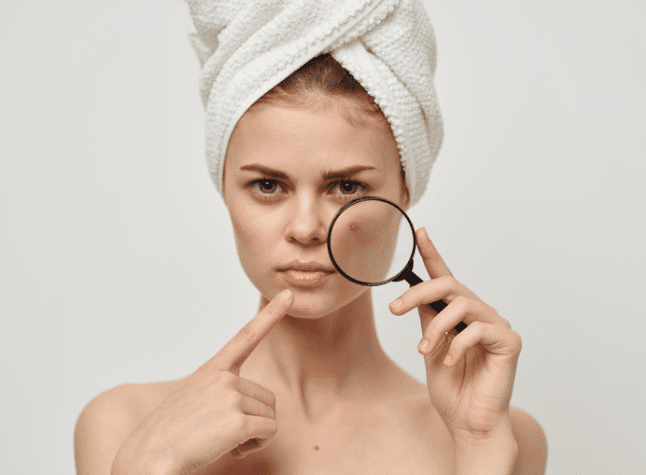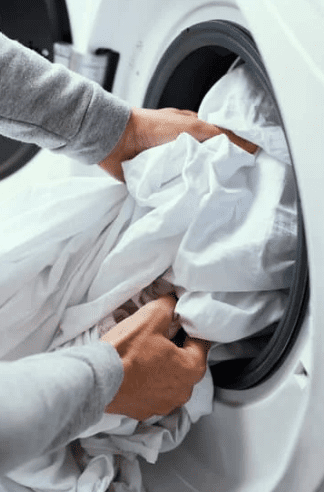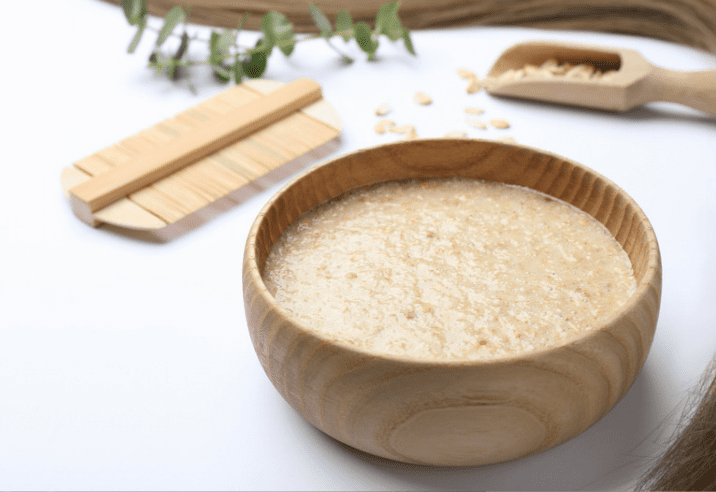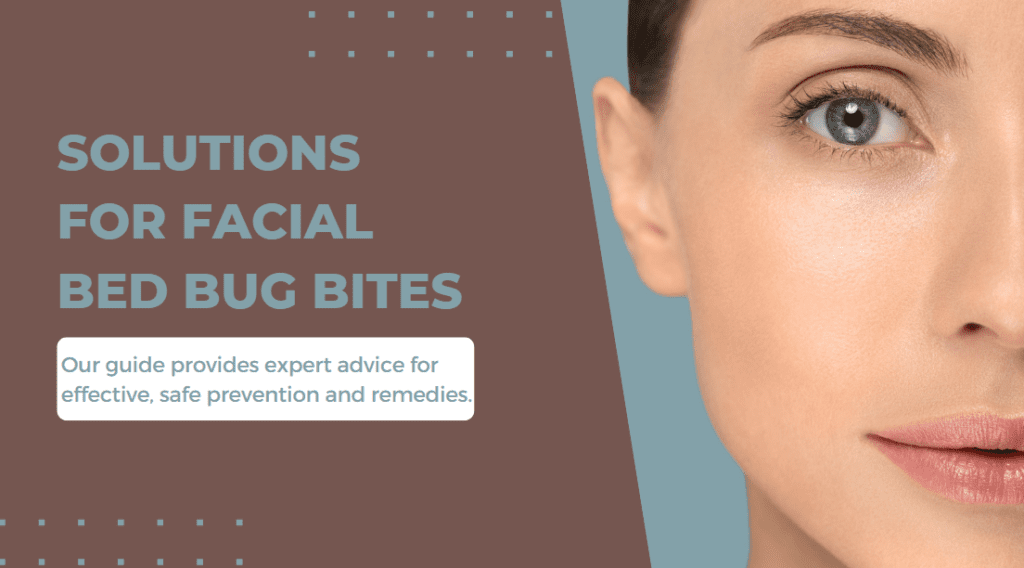Introduction
Solutions for Facial Bed Bug Bites. Welcome to our comprehensive guide on tackling one of the most distressing issues caused by bed bugs: bites on the face. Bed bugs, notorious for their stealthy behavior and nocturnal feeding habits, have become a significant concern in households worldwide. These tiny, elusive pests prefer human blood. Unfortunately, the face, with its exposed skin during sleep, often becomes a target for their bites. In this guide, we aim to provide you with effective, expert-backed solutions to treat and prevent bed bug bites on your face. Ensuring both immediate relief and long-term protection.
Bed bug bites, while not known to transmit diseases, can lead to discomfort, itching, and even secondary skin infections if not managed properly. Identifying these bites early is crucial. Typically, they appear as small, red, and sometimes swollen spots, often in a line or cluster, a telltale sign distinguishing them from other insect bites. These symptoms, while generally mild, can escalate in sensitivity depending on individual reactions and the extent of the infestation.
But why the face, you might wonder?
Bed bugs are attracted to the carbon dioxide we exhale and the warmth of our bodies. Making the face, often uncovered and easily accessible during sleep, an ideal spot for these pests to feed. To combat this, understanding their behavior is key. Our guide delves deep into practical and effective strategies to keep your face bite-free.
Our commitment is not only to provide immediate solutions but also to educate and empower you in bed bug prevention. Whether it’s adopting protective measures in your sleeping environment, understanding the importance of regular bed linen cleaning, or considering professional extermination options, we cover all bases to ensure your peace of mind.
Stay tuned as we unfold a range of tried-and-tested remedies, preventative tips, and expert advice, all aimed at helping you reclaim your comfort and peace from the clutches of bed bugs. Remember, knowledge is your best defense in this battle against bed bugs, and we’re here to arm you with just that.

For more in-depth information on bed bug behavior and their attraction to human hosts, the Environmental Protection Agency (EPA) provides a wealth of resources. You can explore their detailed insights here, which serve as a foundation for many of our recommendations.
As we move forward, let’s dive into understanding bed bug bites more comprehensively. Guiding you through recognizing, treating, and ultimately preventing these unwelcome intruders from disturbing your peace.
Understanding Bed Bug Bites
In this section, we delve into the specifics of bed bug bites, particularly on the face. Bed bug bites are not only a physical nuisance but can also cause psychological distress. It’s essential to recognize these bites and understand their symptoms to address them effectively.
Signs and Symptoms
Bed bug bites on the face manifest as small, red, and often raised welts. These bites frequently appear in a linear or clustered pattern, a distinctive characteristic that sets them apart from other insect bites. It’s common to experience itching, redness, and swelling around the bite sites. However, reactions can vary from person to person. While some might have a mild response, others may experience more pronounced symptoms. It’s crucial to monitor these bites, as excessive scratching can lead to secondary infections.
Reasons for Biting the Face
Understanding why bed bugs are drawn to the face is key in preventing future bites. Bed bugs are attracted to the carbon dioxide we exhale and the warmth of our skin. During the night, our faces are often the most exposed part of our bodies, making them prime targets for these nocturnal feeders. The proximity of bed bugs to sleeping areas, like mattresses and pillows, further increases the likelihood of bites on the face. Recognizing these factors helps in formulating effective strategies to protect ourselves and our sleeping environments from bed bug infestations.
For more information on bed bug behavior and their attraction to human hosts, the Centers for Disease Control and Prevention (CDC) offers extensive resources. Their insights provide valuable context to our discussion here and can be accessed here. Understanding these aspects is a significant step towards effectively managing and preventing bed bug bites, especially on vulnerable areas like the face.
Immediate Actions for Bed Bug Bites on the Face
When you wake up to find bed bug bites on your face, immediate and proper action is crucial. Not only does this alleviate discomfort, but it also prevents further complications. In this section, we’ll guide you through the initial steps to take following the discovery of bed bug bites on your face. Providing practical advice for both immediate care and understanding when it’s time to seek professional medical attention.
First-Aid Measures
As soon as you notice bed bug bites, start with gentle cleansing of the affected area using soap and water. This reduces the risk of infection and helps to alleviate itching. Applying a cold compress can also provide instant relief from swelling and discomfort. For itch relief, over-the-counter treatments like hydrocortisone cream or calamine lotion are effective. It’s important to resist the urge to scratch, as this can exacerbate the irritation and lead to infection. If you have a known allergy to bug bites, it’s advisable to keep an antihistamine handy for immediate use.
When to Seek Medical Attention
While most bed bug bites are harmless and resolve on their own, there are instances when medical intervention is necessary. If you experience symptoms like extreme redness, swelling beyond the bite site, pus, or severe allergic reactions, it’s imperative to seek professional medical help. Additionally, if you notice signs of an infection, such as fever or increasing pain and swelling, a visit to the doctor is warranted. It’s better to err on the side of caution, especially when dealing with bites on sensitive areas like the face.
To further understand the treatment of insect bites and when to seek medical attention, resources from the American Academy of Dermatology provide valuable guidance. Their expertise, accessible here, offers an in-depth look at managing various reactions to bites, reinforcing the steps outlined above.
By taking these immediate actions and being aware of the signs that necessitate medical care, you can effectively manage bed bug bites on the face, ensuring a quicker and safer recovery. Remember, the quicker you respond to these bites, the less discomfort and risk of complications you’ll face.
Long-Term Solutions for Bed Bug Bite Prevention on the Face
Addressing bed bug bites on the face isn’t just about immediate treatment. It’s also about implementing long-term strategies to prevent future occurrences. In this crucial part of our guide, we focus on sustainable solutions that not only provide temporary relief but also contribute to a bed bug-free living environment. By adopting these proactive measures, you can significantly reduce the chances of bed bug bites, especially on the face, which is most vulnerable during sleep.
Preventing Future Bites
One of the most effective long-term strategies is creating a hostile environment for bed bugs in your sleeping area. Start by regularly washing and heat-drying bed linens and pillowcases, as high temperatures kill bed bugs. Consider using bed bug-proof mattress and pillow encasements, which create a barrier that bed bugs cannot penetrate. Be vigilant about checking for signs of bed bugs not just in your bed, but also in nearby furniture and crevices. Reducing clutter around your bed can also limit bed bugs’ hiding spots. Additionally, maintaining a cooler room temperature can make the environment less inviting for these pests.
Controlling Bed Bug Infestations

In the event of an infestation, addressing it comprehensively is key to long-term relief from bed bug bites. Regular inspections and cleaning can help in early detection and control. However, for more severe infestations, professional extermination is often the most effective approach. Pest control professionals can provide targeted treatments, such as heat treatment or insecticides, specifically designed to eliminate bed bugs at all life stages. It’s important to follow their advice and treatment plan diligently to ensure complete eradication. Remember, tackling an infestation early and thoroughly is crucial in preventing future bites and maintaining a bed bug-free home.
The Environmental Protection Agency (EPA) offers a range of resources and guidelines for bed bug control and prevention, which you can explore here. Their recommendations are invaluable in helping you understand and implement effective long-term strategies against bed bugs.
By taking these long-term preventative measures and seeking professional help when necessary, you can significantly reduce the risk of bed bug bites on your face. These steps are not just reactive but are proactive in ensuring your sleeping environment remains safe and comfortable, free from the worries of bed bug infestations.
Home Remedies and Natural Treatments for Bed Bug Bites on the Face
In addition to medical treatments and preventive measures, there are numerous home remedies and natural solutions that can provide relief from bed bug bites, especially on the face. This section explores safe and accessible options that can be easily implemented at home. These remedies are particularly useful for those who prefer a more natural approach or when conventional treatments are not immediately available.
Exploration of Safe, Natural Methods

A variety of natural ingredients found in most households can be effective in alleviating the symptoms of bed bug bites. Aloe vera, known for its soothing and anti-inflammatory properties, can be applied directly to the bite to reduce itching and swelling. Baking soda, when mixed with a small amount of water to create a paste, can be an excellent home remedy for itchy bites. This paste can be applied to the affected area and rinsed off after a few minutes to provide relief. Another simple remedy is oatmeal. Which can be used in baths or as a paste to soothe irritated skin due to its anti-inflammatory properties.
Effectiveness and Preparation of Each Remedy
The effectiveness of these remedies can vary based on the individual’s skin type and the severity of the bites. It is important to test these remedies on a small area of skin first to ensure there is no allergic reaction. Additionally, these natural treatments should be prepared and used correctly to achieve the best results. For instance, fresh aloe vera gel should be extracted from the plant leaf and applied immediately. While oatmeal baths should be lukewarm and not too hot to prevent further irritation of the skin.
For more detailed information on natural remedies and their preparation, the National Center for Biotechnology Information (NCBI) provides a wealth of research-backed insights, which can be accessed here. Their resources can guide you in understanding the science behind these natural treatments and how to use them effectively.
By incorporating these home remedies and natural treatments into your care routine, you can effectively manage the symptoms of bed bug bites on the face. These methods are not only convenient but also gentle on the skin. Making them a great addition to your arsenal against bed bug bites. Remember, while these remedies can provide symptomatic relief, they should be used in conjunction with other preventive measures and treatments for the best results.
Advanced Care for Persistent Issues from Bed Bug Bites on the Face
For some individuals, bed bug bites, especially on the face, can lead to more severe or persistent issues. When home remedies and over-the-counter treatments are not sufficient, it’s essential to explore advanced care options. This section provides insights into prescription treatments and long-term skin care strategies. Ensuring that those with more serious reactions get the help they need for healing and relief.
Prescription Treatments
When over-the-counter medications fail to provide relief, or if you experience severe allergic reactions, prescription treatments may be necessary. Topical corticosteroids are often prescribed by doctors to reduce severe inflammation and itching. In cases of bacterial infection from excessive scratching, antibiotic creams or oral antibiotics might be required. For individuals with extreme allergic reactions, a doctor may prescribe stronger antihistamines or other specific medications to manage the symptoms. It’s crucial to follow your healthcare provider’s guidance closely and use these medications as directed to avoid potential side effects.
Long-term Skin Care
Recovering from bed bug bites, particularly on the face, often requires more than just treating the immediate symptoms. Incorporating a long-term skin care regimen is vital for promoting healing and preventing scarring. Gentle, hypoallergenic cleansers and moisturizers can help restore the skin’s natural barrier. Using products with ingredients like vitamin E and aloe vera can aid in reducing inflammation and enhancing skin repair. It’s also advisable to protect the affected area from sun exposure, as UV rays can worsen scarring or discoloration. Consistent and gentle skin care, along with avoiding harsh chemicals or abrasive treatments, is key to ensuring your skin heals properly and maintains its health.
For those seeking more information on advanced dermatological care and skin healing processes, the American Academy of Dermatology offers comprehensive resources and expert advice. You can access their guidelines and recommendations here.
Seeking advanced care for persistent issues resulting from bed bug bites, especially on sensitive areas like the face, is critical. By utilizing prescription treatments when necessary and adopting a thoughtful skin care routine, you can effectively manage more severe reactions and promote long-term skin health. Remember, the goal is not only to treat the symptoms but also to ensure your skin recovers fully and remains resilient against future challenges.
Preventive Measures and Lifestyle Adjustments to Avoid Bed Bug Bites on the Face
Preventing bed bug bites, particularly on the face, goes beyond immediate remedies and treatments. It encompasses a series of preventive measures and lifestyle adjustments that can significantly reduce the risk of bed bug infestations and, consequently, bites. This section explores a range of strategies to maintain a bed bug-free environment. Focusing on both personal habits and home maintenance practices that are essential for long-term prevention.
Comprehensive Advice on Lifestyle Changes
Making lifestyle changes is a key step in preventing bed bug bites. This involves being vigilant when traveling. Bed bugs are often brought into homes via luggage and clothing from infested areas. Regularly inspecting and vacuuming luggage after trips can help prevent the introduction of bed bugs into your home. Additionally, being cautious when acquiring second-hand furniture or mattresses is crucial, as these items can be sources of bed bugs. It’s also beneficial to educate yourself and your family about bed bug prevention and identification. Thus, creating a more informed and proactive household.
Maintaining a Bed Bug-Free Environment
Keeping your living space clean and clutter-free is vital in preventing bed bug infestations. Regular cleaning, including vacuuming carpets and furniture, can help remove any bed bugs or eggs that may be present. Sealing cracks and crevices in walls, floors, and furniture denies bed bugs hiding places, further reducing the likelihood of an infestation. Using protective covers on mattresses and pillows can also prevent bed bugs from taking residence in your bedding. In multi-unit living spaces, coordinating with neighbors and property management for regular inspections and treatments can be an effective communal approach to bed bug prevention.
The United States Environmental Protection Agency (EPA) offers additional guidelines and tips for preventing bed bug infestations, which can be found here. Their resources provide a deeper understanding of the steps you can take to keep your home bed bug-free.
By implementing these preventive measures and making thoughtful lifestyle adjustments, you can greatly reduce the chances of encountering bed bug bites on your face. These strategies not only address the immediate issue but also contribute to creating a healthier, more comfortable living environment. Remember, prevention is always better than cure. And taking these proactive steps can save you significant discomfort and inconvenience in the long run.
Conclusion: Empowering You in the Fight Against Bed Bug Bites on the Face
As we conclude this comprehensive guide on dealing with bed bug bites on the face. It’s important to emphasize the power of knowledge and proactive measures in this battle. Through understanding, immediate action, and long-term strategies, you are now equipped with the tools needed to effectively manage and prevent these troublesome bites. Remember, the key is not just in treating the symptoms but in addressing the root cause – the bed bugs themselves.
Recap of Key Points
We’ve explored a range of topics, from identifying and treating bed bug bites on the face to implementing long-term preventive measures. Immediate actions like proper first-aid and knowing when to seek medical attention are crucial in managing the immediate discomfort. Long-term solutions, including maintaining a bed bug-free environment and making lifestyle adjustments, play a vital role in preventing future infestations. We also delved into natural remedies and advanced care options, providing a holistic approach to dealing with bed bug bites.
Encouragement for Proactive Measures
Taking proactive steps, staying informed, and being vigilant are your best defenses against bed bugs. Regular inspections, cleanliness, and adopting preventive strategies can go a long way in keeping your home bed bug-free. It’s also beneficial to stay updated with the latest information and resources on bed bug management.
For additional support and resources, consider visiting the National Pest Management Association’s website here. They offer valuable insights and updates on pest control methods and bed bug management strategies.
Final Thoughts
Dealing with bed bug bites on the face can be a challenging experience. But with the right knowledge and tools, it’s a battle you can win. By applying the information and techniques discussed in this guide, you can protect yourself and your loved ones from the discomfort and stress caused by bed bug bites. Stay vigilant, be prepared, and remember that prevention is always better than cure. With these strategies in hand, you can achieve peace of mind and a bed bug-free living space.




